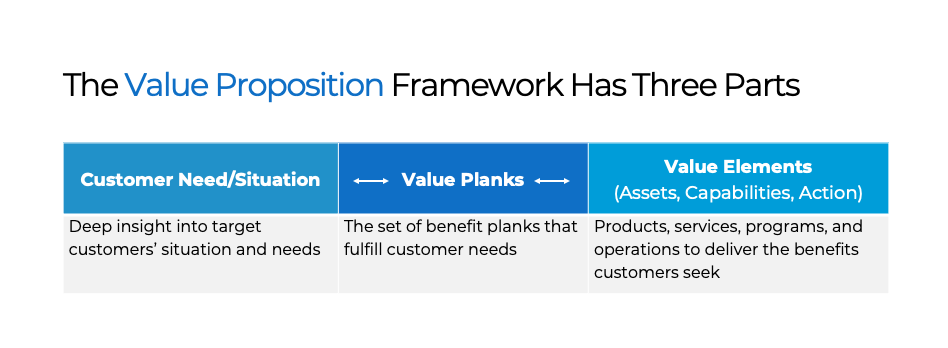The Definitive Guide to Value Proposition Development
 At EquiBrand Consulting, we specialize in helping businesses develop robust value propositions that align with customer needs, enhance brand differentiation, and drive business growth. A value proposition is not just a simple statement—it’s a multidimensional framework that connects actionable customer insights with operational capabilities, delivering both tangible and emotional benefits.
At EquiBrand Consulting, we specialize in helping businesses develop robust value propositions that align with customer needs, enhance brand differentiation, and drive business growth. A value proposition is not just a simple statement—it’s a multidimensional framework that connects actionable customer insights with operational capabilities, delivering both tangible and emotional benefits.
In this guide, we’ll walk you through the essential elements of value proposition development, using our proprietary Value Proposition Framework approach. Whether you’re refining an existing value proposition or creating a new one, our comprehensive approach ensures your business delivers value that resonates with customers and drives sustainable success.
What is a Value Proposition?
A value proposition defines the key benefits your product or service offers to target customers. Structurally, a value proposition consists of four to six benefit-based planks, each representing a specific customer benefit such as convenience, peace of mind, or enhanced performance. These planks, when combined, form a full value stack—the complete value proposition for your offering.
Just as an organization can have multiple brands, it can also have multiple value propositions at various levels—corporate, business unit, and product or service levels. At EquiBrand Consulting, we work with companies to design and align these value propositions across all levels, ensuring they deliver a relevant and distinctive offering to customers while driving organizational alignment.
Value Proposition Framework: A Three-Part Design Approach
A well-structured value proposition framework translates customer insights into business terms, allowing you to make better decisions and develop actionable plans. Our Value Proposition Framework includes three critical components:

1. Customer Situation
- This part focuses on gaining deep insights into the target customer’s current and future needs. Understanding what your customers want, what challenges they face, and how they behave provides the foundation for designing a relevant value proposition. We obtain this insight through a combination of research methods, including in-depth interviews, ethnographic studies, and data analytics.
2. Value Planks
- These are the key benefits your business offers to meet customer needs. Value planks can range from functional benefits (e.g., convenience, performance) to emotional or self-expressive benefits (e.g., brand prestige, personal fulfillment). The combination of these planks forms your full value proposition, making it relevant and distinctive in the marketplace.
3. Operational Value Elements
- These are the internal capabilities, competencies, and assets required to deliver the promised value. Examples include technical expertise, superior customer service, or advanced manufacturing capabilities. Aligning your operational strengths with your value planks ensures that your business can reliably deliver on its value proposition.
This structured approach ensures that your business creates and captures value effectively, aligning customer needs with the operational elements required to meet them.
Value Proposition Design Approach: Aligning Value Across Your Organization
Our proprietary Value Proposition Design Approach takes value proposition development a step further by aligning it across all levels of your organization. Much like developing a new product, creating a value proposition involves defining and delivering a broader set of benefits. The process includes:
- Creating a multidimensional definition of brand value by combining various value planks that together create a compelling offering.
- Driving strategic direction by identifying and owning the benefits that matter most to customers and on which your category decisions are made.
- Focusing resource allocation to ensure your efforts and investments are directed toward delivering the benefits that have the highest impact on your target customers.
- Aligning strategies across the organization, ensuring each department—marketing, sales, product development, and customer service—is focused on delivering value in a cohesive and coordinated manner.
This approach ensures your value proposition is not only relevant to customers but also fully integrated across your business, from strategy to execution.
Benefits of a Strong Value Proposition
A well-crafted value proposition offers numerous benefits to both customers and your organization:
1. Multidimensional Brand Value
- A strong value proposition encompasses multiple value planks, each addressing different aspects of customer needs. The more comprehensive and multidimensional the proposition, the higher the perceived value by customers.
2. Customer Engagement and Loyalty
- By going beyond the core product or service, businesses can deepen their relationship with customers. For example, Amazon and Nike extend their value proposition through features like Amazon Prime or Nike Membership, enhancing customer engagement and loyalty through additional offerings and touchpoints.
3. Strategic Alignment
- A value proposition serves as a strategic guidepost for your organization, helping prioritize initiatives and focus innovation efforts on what matters most to your customers. It also provides a framework to evaluate new opportunities, ensuring that any innovations or extensions align with your brand’s core value planks.
4. Focused Innovation
- A clear value proposition helps guide innovation efforts, ensuring that new initiatives align with customer expectations and your brand’s identity. It provides a filter for which opportunities to pursue and which to avoid, ensuring that resources are used efficiently.
Examples of Strong Value Propositions
Some of the most successful companies, like Amazon, Southwest Airlines, and Starbucks, have developed multidimensional value propositions that go beyond a single statement. These companies integrate multiple value planks—functional, emotional, and self-expressive—to create a compelling and cohesive customer experience.
At EquiBrand, we help businesses design value propositions that mirror this approach, ensuring that each plank delivers a distinct benefit while reinforcing the overall brand value.
Value Proposition Design: Balancing Cost and Value
A strong value proposition balances what customers get for what they pay. This balance can be achieved in two ways:
- Adding benefits to increase value without necessarily lowering the cost.
- Lowering costs while maintaining or enhancing the benefits provided.
At EquiBrand, we typically focus on improving the value customers receive by enhancing the benefits delivered, unless your business is positioned as the absolute lowest-cost provider. Programs like subscription services, loyalty programs, or product enhancements can increase perceived value and allow for premium pricing.
Why Choose EquiBrand for Value Proposition Development?
At EquiBrand Consulting, we bring decades of experience and a proprietary approach to value proposition development that combines customer insight, brand identity, and innovation. Drawing on our Upstream Marketing frameworks, we help businesses develop value propositions that are:
- Relevant to customer needs and aligned with market opportunities.
- Distinctive in offering a unique combination of benefits that set you apart from competitors.
- Credible, ensuring your brand delivers on its promises both operationally and financially.
With our Value Proposition Framework and Value Stack Design Approach, we ensure that your business develops a comprehensive, customer-centric value proposition that drives both growth and differentiation.
Start Developing Your Value Proposition Today
Ready to design a value proposition that aligns with your customers’ needs and drives organizational growth? Contact EquiBrand Consulting to learn how we can help you create and deliver a compelling value proposition that resonates in the marketplace and sets your business up for success.
About EquiBrand Consulting
At EquiBrand Consulting, we specialize in strategic marketing, brand development, and value proposition consulting. Our proprietary frameworks, including insights from the book Upstream Marketing, have helped businesses across industries define their value, innovate successfully, and create lasting customer relationships.
















Follow EquiBrand